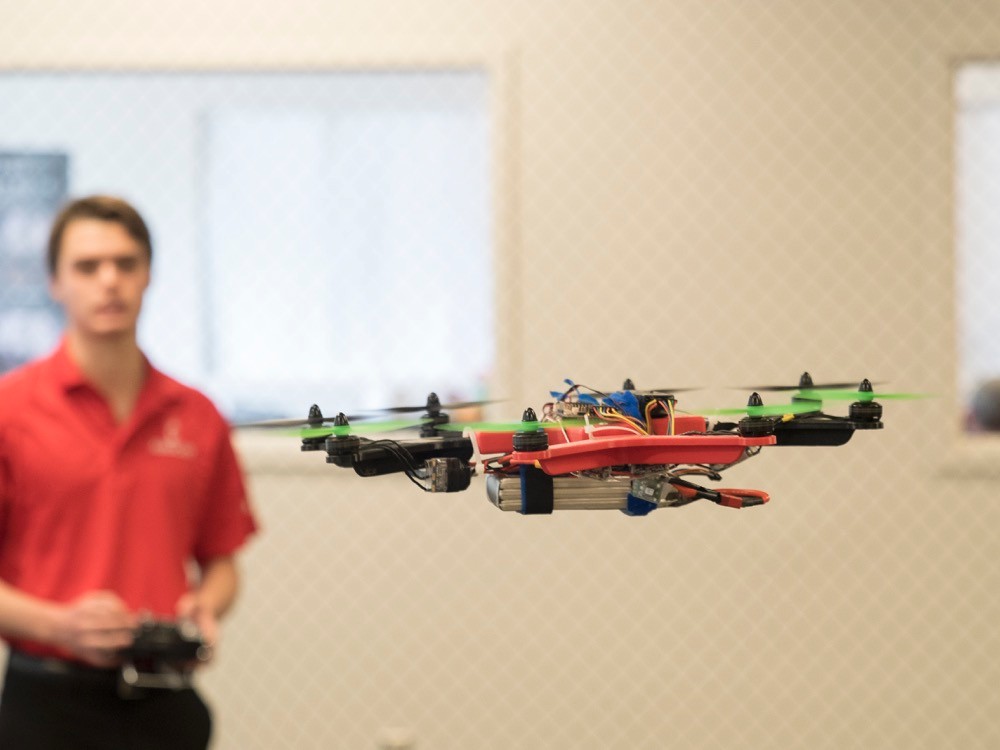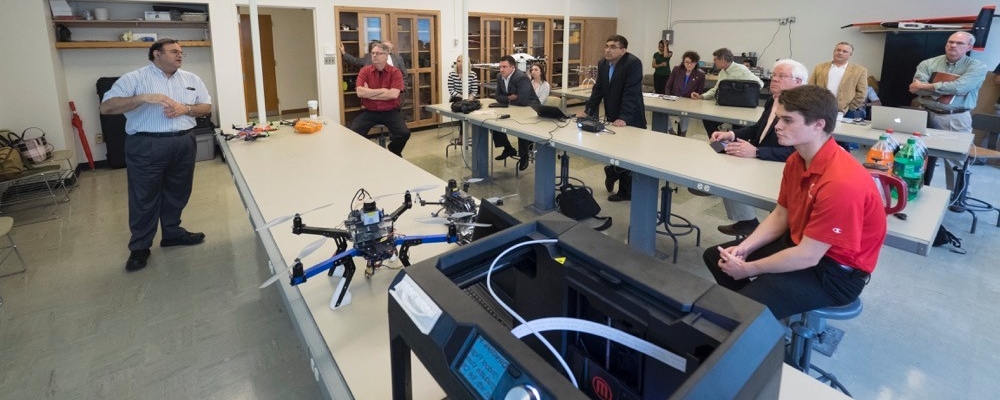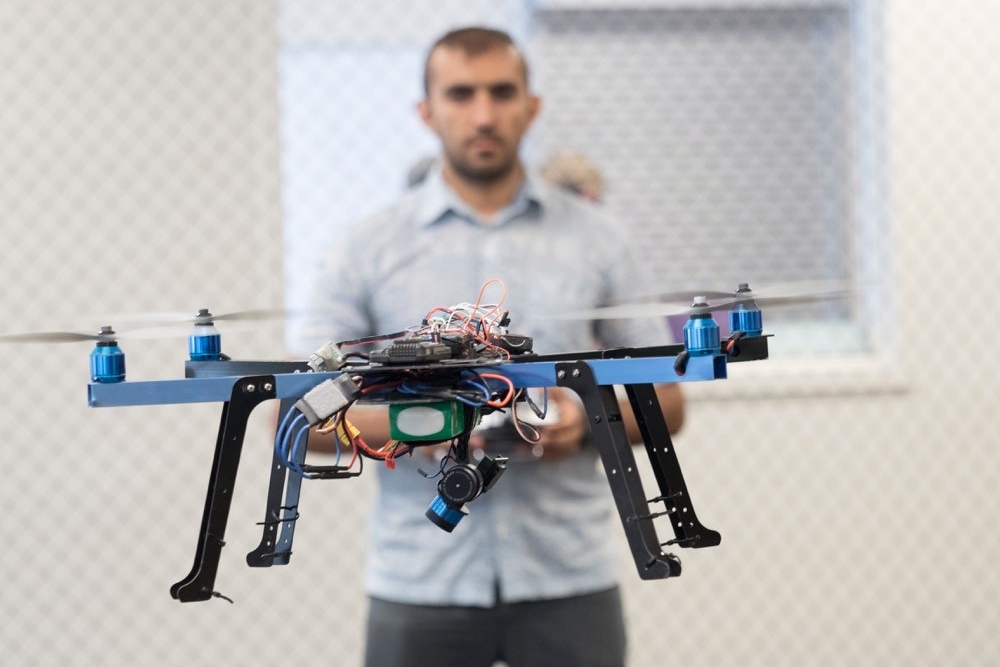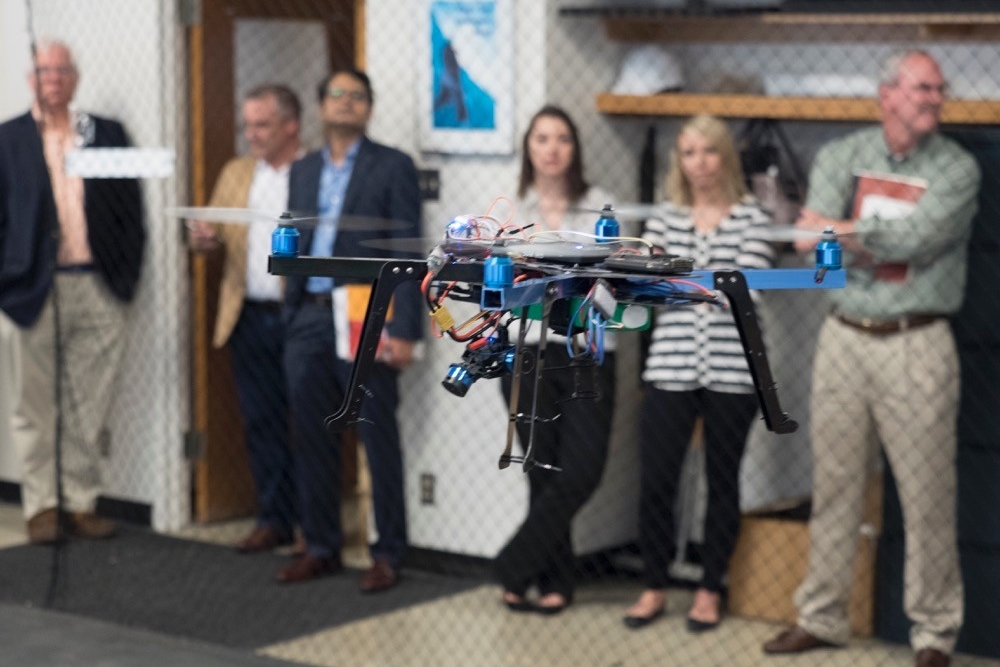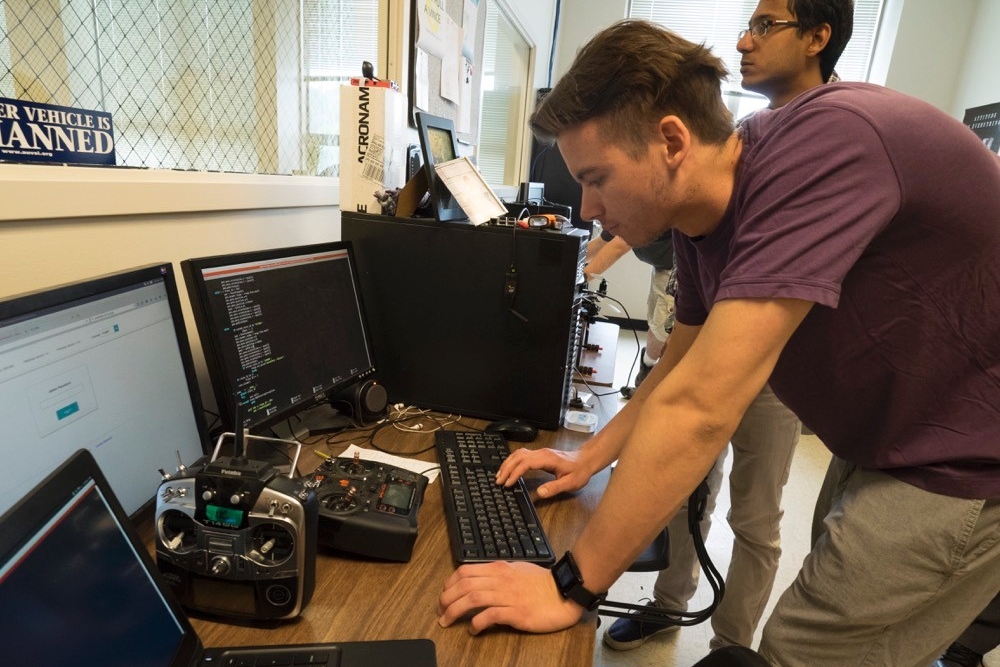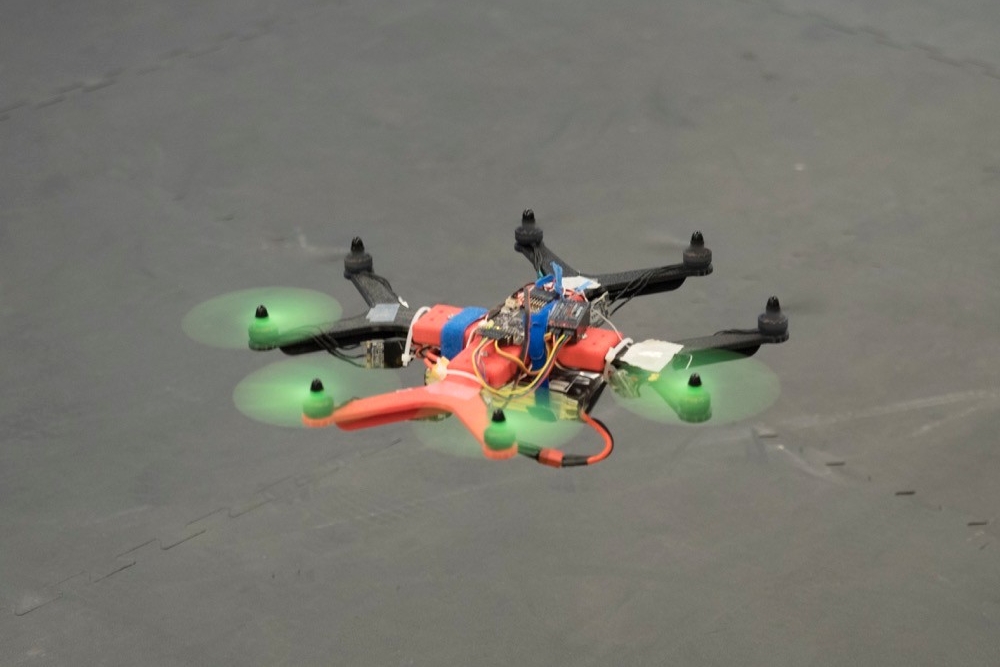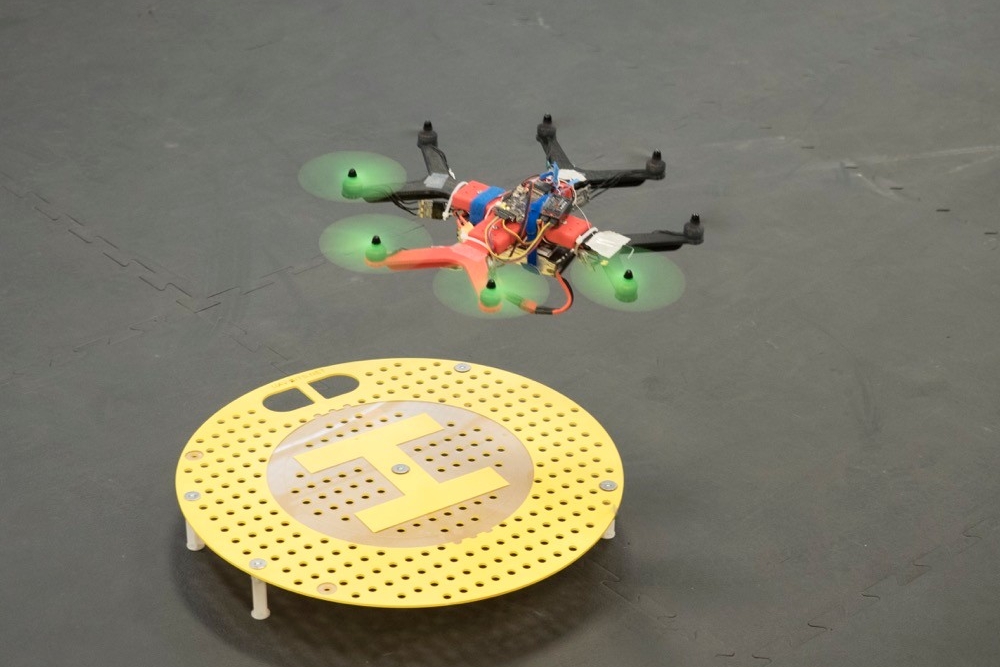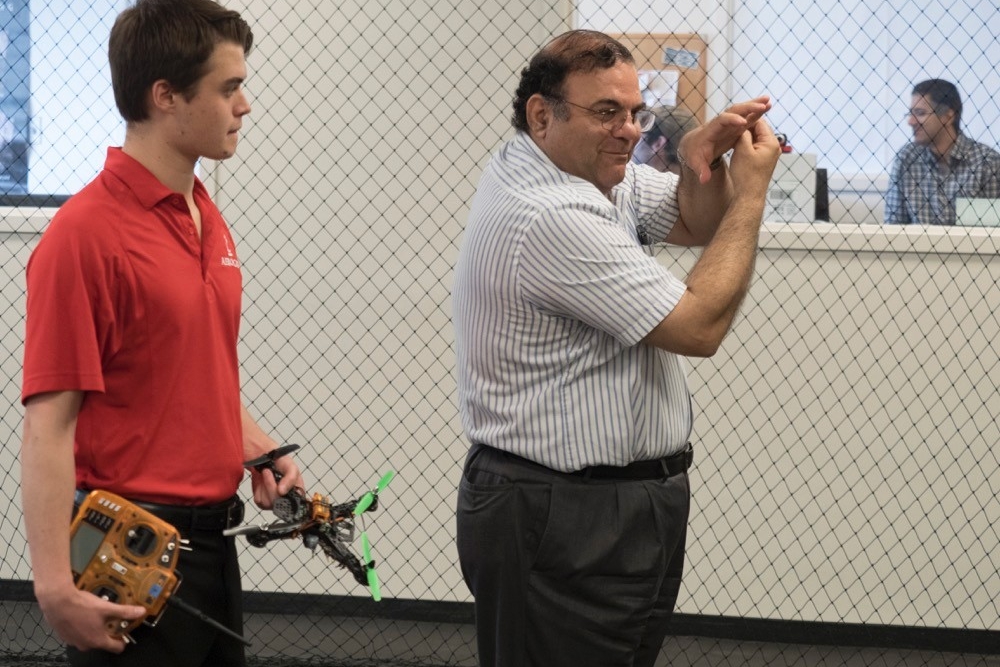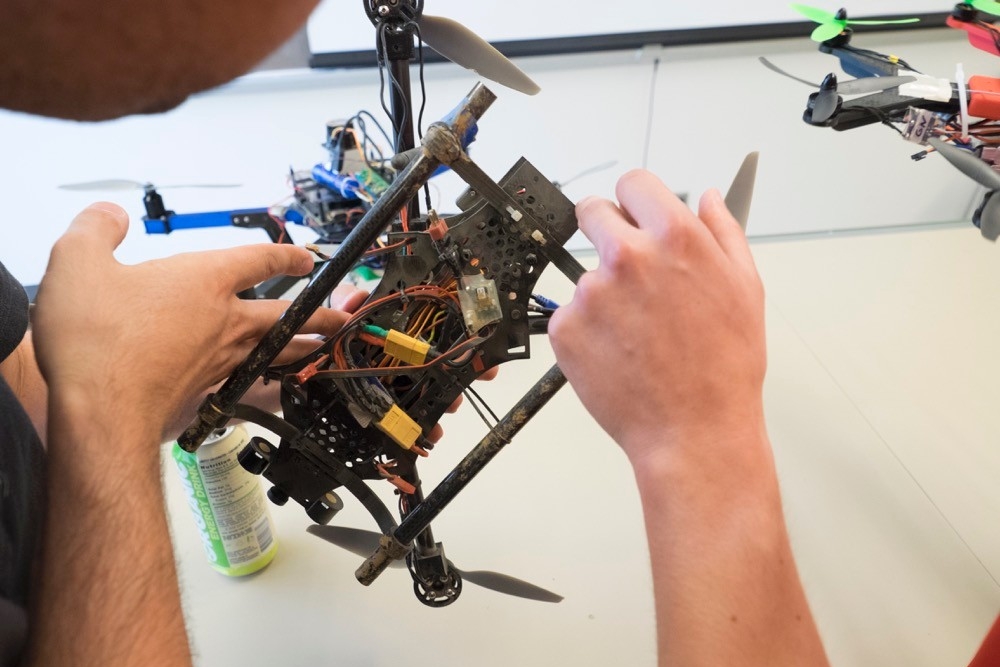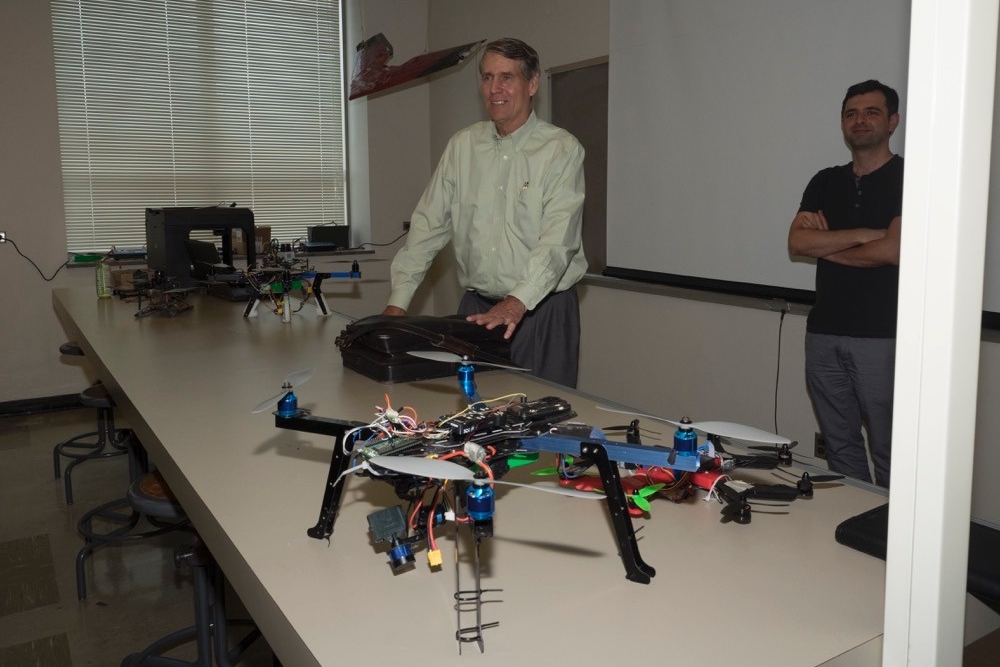UC engineering student Nathaniel Richards demonstrates the ease in operating an octocopter UAV drone.
Can Drones Save Lives? The Sky’s the Limit
UC workshop on Aug. 10 demonstrates advantages of using unmanned aerial vehicles in emergencies.
By Melanie Schefft
513-556-5213
Photos: Jay Yocis/UC Creative Services
August 4, 2016
Rescue drones, or unmanned aerial vehicles (UAVs) are attracting a lot of attention in the world of emergency management lately, and the trend is not about to stop.
“When disaster strikes, incident commanders now have a new tool,” says Lawrence Bennett, program chair of the University of Cincinnati’s Fire Science & Emergency Management. “UAVs are equipped with infrared cameras and other sensors that can help emergency responders save lives.
“From a control pad, trained operators can even send UAVs into hazardous situations to collect air and liquid samples for on-scene analysis.”
To keep firefighters and other first responders up-to-date and trained on the new technology, UC will present a free seminar on Aug. 10, that will bring together teams of faculty experts from UC’s College of Engineering and Applied Science, along with guest speakers from fire and emergency management and the Federal Aviation Administration (FAA).
Over 150 fire, police and other emergency personnel from throughout the nation have registered for “Unmanned Aerial Vehicles (UAV) for Emergency Responders,” which will include flights in the UC Aerospace Flight Lab on Victory Parkway, and is expected to run from 9 a.m. to 3:30 p.m.
A drone demonstration will take place noon-1 p.m., Wednesday, Aug. 10, in the auditorium of UC's Victory Parkway Campus, 2220 Victory Parkway, 45206. The auditorium is located on the 4th floor of the Science Building. See the map of the Victory Parkway Campus.
Kelly Cohen, UC professor of aerospace engineering discusses the advantages of using UVAs in disasters.
Throughout the seminar, participants will discover:
- UAV opportunities and challenges
- UAV and Air Care helicopters at disaster scenes
- UAV systems for emergency management
- FAA Section 107 approval process
- Tour Command 400 rescue vehicle from Greater Cincinnati HAZMAT Unit
- Observe and work hands-on with a variety of UAVs inside UC’s Aerospace Flight Lab
- Afternoon breakout sessions will conclude with suggestions on specific topics to be covered in UC’s upcoming three-credit course to be offered in 2017
UC engineering student Alireza Nemati demonstrates to faculty and students the ease in operating a drone that can be used for emergency surveillance.
High hopes
“The possibilities for using drones in emergencies are endless,” says Kelly Cohen, UC professor of aerospace engineering and engineering mechanics. “The goal of the seminar is to demonstrate how we can improve existing emergency infrastructure with a network of drones.”
The secret to the success of UC’s drone research comes in large part because of Cohen, a presenter at the seminar who brought his expertise to UC in 2012 after 15 years of career building and teaching UAV technology in Israel. Since joining the faculty, Cohen has been teaching UC students the wonders of defying gravity through developing UAVs and providing the inspiration for an artificial intelligence flight simulation program.
In conjunction with Manish Kumar, UC associate professor of mechanical engineering, Cohen’s team of UC faculty and students has been building mobile robots, quadrocopters and octocopters like the HorseFly, some of which will be seen in the August 10 seminar. With this multirotor delivery drone –– designed in partnership with AMP Holdings Company –– Cohen’s team has pushed the boundaries and opened opportunities for collaborating with industry partners.
The researchers say, depending on their size, drones can navigate through tight spaces or travel through open sky at over 100 km/h, reaching their destination within minutes. This can improve the chances for a victim’s survival from less than 10 to over 80 percent.
UC students operate a UAV from the command center inside UC Aerospace Flight Lab.
“Smaller UAVs such as camera-equipped four-rotor drones, can not only show emergency responders where the most critical needs are in a fire or catastrophic situation, but can detect where to look for survivors inside buildings using heat-sensing infrared optical gear,” says B.J. Jetter, adjunct professor of UC Fire Science.
The researchers are also are looking at communication components using nanotooth technology for transmitting signals through heavy barriers.
“A lot of times a firefighter is in a building that is too shielded because of all the steel, which hinders their ability to transmit communications to responders outside the building,” says Jetter, also a retired fire chief for Sycamore Township. “But some of this new technology can be worn inside the firefighters’ gear as an antenna to boost their signal.”
By using a drone that can hover over a building, Jetter, who will be presenting at the seminar, says it can actually act as a repeater of the signals from the firefighters back to the command post and can monitor carbon dioxide and air quality levels in the smoke –– and alert the general community and firefighters going into the hazards.
Rescue’s new tool
In addition to monitoring burning buildings, Jetter says a drone’s speed and ability can also mean the difference between getting help to victims in minutes instead of hours –– especially in search and rescue missions or surveying along a river for water accidents.
“We don’t have that ability with standard equipment, but this drone technology brings all of that to us,” says Jetter. “This is the greatest thing I have seen.”
With almost $4 million in combined secured-grant funding, Cohen’s research arm reaches far and wide, benefiting from collaborative support from NASA’s Langley and Ames research centers, Ohio Space Grant Consortium, National Science Foundation, U.S. Air Force, U.S. Army and private industry.
After securing certificates of authorization (COA) by the FAA in 2015, faculty and students in UC’s Department of Aerospace Engineering and Engineering Mechanics and Department of Mechanical and Materials Engineering have had success testing five types of UAVs in a designated area inside Wilmington Air Park, in Wilmington, Ohio, less than an hour’s drive from campus.
Those COAs have been especially beneficial for the National Science Foundation-funded project, “Situational Awareness during Fire and Emergency (SAFE),” supervised by Cohen and Kumar.
“This has allowed us to continue our collaboration with the Cincinnati Fire Department and West Virginia Division of Forestry to create UAV-based solutions for large-scale disasters,” says Bennett, also a UC associate professor of fire science in the College of Engineering and Applied Science.
UC Professors Kelly Cohen (L) and Larry Bennett (far R) demonstrate the value of drones in emergency situations.
A future for flying toys
In a demonstration for the Ohio Department of Transportation, Cohen and his engineering colleagues gave a live choreographed display of the whirling workhorses of all shapes and sizes, underscoring their ability to carry needed tools, medical supplies and provide valuable surveillance.
Cohen says cameras and GPS software on UAVs are critically important for drone-to-operator communication. Participants at the seminar will see that by maneuvering a joystick or touchpad on a smart device, the operator can control the speed, altitude and direction of the unit, as well as the direction and zoom of the camera. First responders can then quickly assess the scope of the damage from a portable monitor and send help to the areas in the most critical need.
In the future, Cohen sees his team focusing more closely on incorporating the field of robotics with aerial vehicles. He looks forward to developing a multicopter system with robotic arms that can collaborate to fix electrical wires, aid in building construction and valuable military operations.
“We want to teach our students to not only build ‘big data’ on paper, but to go beyond that in the area of pragmatic applications –– to teach our students to be bold, to push the envelope and turn their ideas into reality,” says Cohen. “If you look at our past students and where they are today, you can see why we are so proud and encouraged by the endless possibilities.
“The more ideas we can dream up, the more technology we can create,” says Cohen. “The sky’s the limit.”
UC engineering students iook forward to the future of UAV research.

